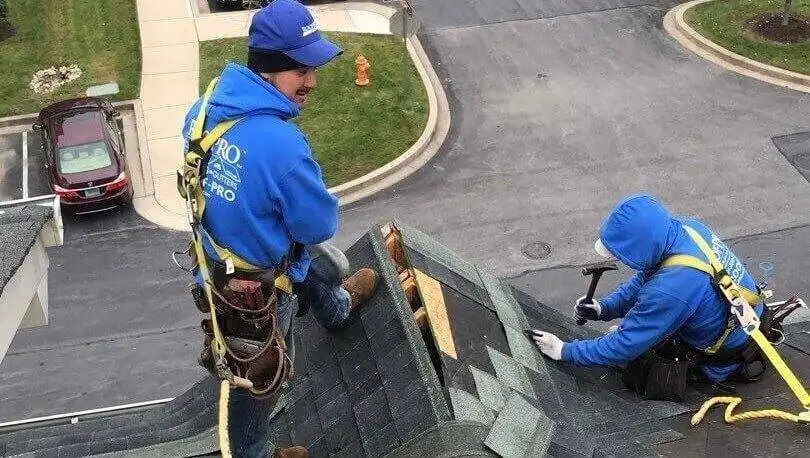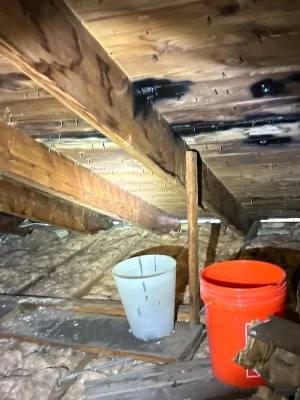Water stains creeping across your ceiling isn’t something to ignore. Whether the problem starts with a roof leak, poor attic ventilation, or flashing that’s given out, leaks can quickly lead to structural damage, mold growth, and higher repair bills if not handled promptly. At RoofPRO, we help Maryland homeowners stop ceiling damage from occurring at the source and prevent it from coming back.

What Causes Ceiling Leaks?
Moisture coming through the ceiling doesn’t always mean a leaky roof; that is just the most common cause. Our team investigates the leak to pinpoint the source. Most leaks stem from one of the following categories.
Common Issues Behind a Roof Leak
- Broken or Missing Shingles: Heavy storms and wind can dislodge shingles, especially if they’re already aging or cracked. Even a small gap in your roofing surface gives rain a way in.
- Worn Flashing or Vent Boots: Roof flashing is the thin metal installed around chimneys, vents, and skylights. When it shifts or loosens, water sneaks underneath and can travel down into your attic and ceiling.
- Clogged or Damaged Gutters: If your gutters are clogged or misaligned, rainwater can back up and seep under the roofing material.
- Improper Roof Penetrations: Roof pipes, skylight, plumbing vents, and attic fans all require precise waterproofing. If those seals fail, water follows gravity right down into your ceiling.
- Underlayment Failure: The waterproof membrane beneath your shingles can break down over time. Without that protection, water moves through the roof decking and reaches inside your home.
- Ice Dams: Maryland’s seasonal freeze-thaw cycles can cause ice dams along roof edges. Water builds up behind them, sometimes seeping under shingles and into the attic.
- Poor Attic Ventillation: Poor insulation and ventilation can create issues that resemble external leaks. In summer, hot attics combined with humid air create a breeding ground for condensation and mold.
A Leak Spot Doesn’t Always Mean Your Roof is Leaking
Sometimes, the ceiling stain isn’t from the roof at all. Other culprits include:
- Leaking pipes: A pipe in an attic or cavity can leak slowly over time or burst suddenly. This is common in older homes or during freezing temperatures.
- HVAC condensation: In summer, air conditioning ducts and coils produce moisture. If the drainage system backs up or insulation is missing, water can drip onto your ceiling.
- Bathroom exhaust leaks: Moisture from poorly vented bathrooms can collect in cavities, creating stains or soft spots that mimic roof-related leaks.

How to Tell if Water Damage is Coming From Your Roofing System
If the leak shows up even when it hasn’t rained, or if it only appears when the shower runs, the problem might be inside your home. But if it happens during or consistently after heavy rainfall, the roof is more likely the issue.
The shape of the stain can help determine the cause of the leak spot. Brownish rings that grow outward often come from slow roof leaks. Attic inspection may reveal more. If it’s safe, go into the attic during or after rain. Look for wet insulation, moldy wood, or trickles coming through the roof deck.
At RoofPRO, we never guess. We use moisture meters, thermal cameras, and visual attic inspections to locate the leak source before we start any repairs.
Why Prompt Repairs Matter
Home leaks aren’t just an eyesore. Left unchecked, they lead to bigger, more expensive problems.
- Mold and mildew can spread through water-damaged drywall, attic insulation, and carpet. This affects indoor air quality and poses health risks, especially for children and seniors.
- Insulation loses effectiveness when wet. That means higher energy bills and uncomfortable indoor temperatures.
- Structural damage builds over time. Wooden rafters and joists can rot, drywall may collapse, and electrical wiring may become exposed to moisture.
- Insurance claims may be limited if you wait too long. Many policies only cover sudden or accidental leaks (not long-term neglect). If the leak results from poor maintenance or gradual wear, coverage may be denied. Immediate documentation, photos, and a professional diagnosis help support your claim. RoofPRO provides written inspection reports and photos upon request.
Calling a roofing professional quickly is the safest and most cost-effective path forward.
Why DIY Repairs Often Make Things Worse
Covering a stain without stopping the leak guarantees it will return. Water damage tends to spread quietly. You may miss signs of mold, soaked insulation, or structural issues if you’re only addressing the surface. Roofing work also involves climbing, tools, and materials that require training to handle safely.
Professional repairs are safer and cost less than the risk of more extensive damage caused by letting the issue grow.

RoofPRO’s Leak Detection and Repair Solutions
We’ve been fixing leaks across Maryland for more than two decades. Every project begins with a thorough inspection to pinpoint the source and ends with a lasting repair you can count on. As certified installers with GAF, CertainTeed, Owen Corning, and VELUX, RoofPRO follows manufacturer-approved standards to ensure every repair meets the highest level of quality and durability.
Leaky Roof Repair or Replacement Solutions
Depending on the severity, we may recommend:
- Replacing missing shingles or damaged flashing
- Resealing roof penetrations (vents, chimneys, skylights)
- Repairing underlayment and roof decking
- Replacement of the roof (if damage is widespread or the roof is nearing the end of its service life)
We walk homeowners through every repair option and explain the pros, cons, and cost implications before any work begins.
Emergency Response
If the leak is active during a storm, we offer temporary tarp roof coverage or water diversion to protect your interior until full repairs can be completed. Our emergency response team is available 24/7 during major weather events for both commercial and residential roofing.

FAQs About Fixing Leaks
It depends on the severity of the roof damage and the extent of the repairs. Small roof patches may cost a few hundred dollars, while major roof repairs or replacements could range into the thousands. We provide honest, upfront quotes with no surprise charges.
You can patch drywall or repaint, but that won’t stop the water. Ceiling water leak repairs require addressing the source. DIY fixes may hide the problem but won’t prevent further damage.
Contain the leak if water is dripping by using a bucket or plastic sheeting. Move furniture, electronics, and personal items out of the area. If your home has sagging ceilings, call us before puncturing them to drain.
Schedule Your Inspection with RoofPRO Today
If you’re seeing stains, holes, sagging, or signs of water entry, don’t wait. RoofPRO offers fast, reliable roof leak detection and repairs across Maryland. We respond quickly, explain everything clearly, and fix the issue completely.
Contact us today to schedule your inspection. One visit from our team can stop the damage in its tracks and restore your peace of mind.
Article Updated November 1, 2025.

Author Bio
Tim Taylor – Owner & Founder of RoofPRO
Tim Taylor began his roofing career in 2003 and founded RoofPRO in 2004 with a mission to fix the poor workmanship that often causes roof leaks. With over 20 years of hands-on experience, he’s earned elite credentials like CertainTeed’s ShingleMaster Wizard certification, HAAG inspection certifications, and OSHA safety training. His expertise in leak repair, flashing repair, and post-storm restoration has made RoofPRO one of Maryland’s most trusted roofing companies. Tim continues to lead with the same principle that built his reputation—roof it right the first time


